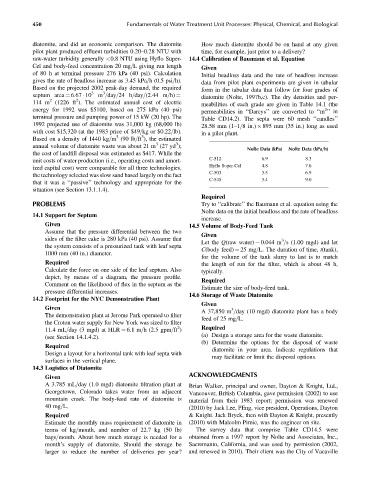Page 495 - Fundamentals of Water Treatment Unit Processes : Physical, Chemical, and Biological
P. 495
450 Fundamentals of Water Treatment Unit Processes: Physical, Chemical, and Biological
diatomite, and did an economic comparison. The diatomite How much diatomite should be on hand at any given
pilot plant produced effluent turbidities 0.20–0.28 NTU with time, for example, just prior to a delivery?
raw-water turbidity generally <0.8 NTU using Hyflo Super- 14.4 Calibration of Baumann et al. Equation
Cel and body-feed concentration 20 mg=L giving run length Given
of 80 h at terminal pressure 276 kPa (40 psi). Calculation Initial headloss data and the rate of headloss increase
gives the rate of headloss increase as 3.45 kPa=h (0.5 psi=h). data from pilot plant experiments are given in tabular
Based on the projected 2002 peak-day demand, the required form in the tabular data that follow for four grades of
3 3
septum area ¼ 6.67 10 m =day=24 h=day=(2.44 m=h) ¼ diatomite (Nolte, 1997b,c). The dry densities and per-
2 2
114 m (1226 ft ). The estimated annual cost of electric meabilities of each grade are given in Table 14.1 (the
energy for 1992 was $5100, based on 275 kPa (40 psi) permeabilities in ‘‘Darcys’’ are converted to ‘‘m ’’ in
2
terminal pressure and pumping power of 15 kW (20 hp). The Table CD14.2). The septa were 60 mesh ‘‘candles’’
1992 projected use of diatomite was 31,000 kg (68,000 lb) 28.58 mm (1–1=8 in.) 895 mm (35 in.) long as used
with cost $15,320 (at the 1983 price of $49=kg or $0.22=lb). in a pilot plant.
3
3
Based on a density of 1440 kg=m (90 lb=ft ), the estimated
3
3
annual volume of diatomite waste was about 21 m (27 yd );
Nolte Data (kPa) Nolte Data (kPa=h)
the cost of landfill disposal was estimated as $417. While the
unit costs of water production (i.e., operating costs and amort- C-512 6.9 8.3
ized capital cost) were comparable for all three technologies, Hyflo Super-Cel 4.8 7.6
C-503 3.5 6.9
the technology selected was slow sand based largely on the fact
C-545 3.4 9.0
that it was a ‘‘passive’’ technology and appropriate for the
situation (see Section 13.1.1.4).
Required
PROBLEMS Try to ‘‘calibrate’’ the Baumann et al. equation using the
Nolte data on the initial headloss and the rate of headloss
14.1 Support for Septum
increase.
Given 14.5 Volume of Body-Feed Tank
Assume that the pressure differential between the two
Given
sides of the filter cake is 280 kPa (40 psi). Assume that 3
Let the Q(raw water) ¼ 0.044 m =s (1.00 mgd) and let
the system consists of a pressurized tank with leaf septa
C(body feed) ¼ 25 mg=L. The duration of time, t(tank),
1000 mm (40 in.) diameter.
for the volume of the tank slurry to last is to match
Required the length of run for the filter, which is about 48 h,
Calculate the force on one side of the leaf septum. Also typically.
depict, by means of a diagram, the pressure profile.
Required
Comment on the likelihood of flex in the septum as the
Estimate the size of body-feed tank.
pressure differential increases.
14.6 Storage of Waste Diatomite
14.2 Footprint for the NYC Demonstration Plant
Given
Given 3
A 37,850 m =day (10 mgd) diatomite plant has a body
The demonstration plant at Jerome Park operated to filter
feed of 25 mg=L.
the Croton water supply for New York was sized to filter
2
11.4 mL=day (3 mgd) at HLR ¼ 6.1 m=h (2.5 gpm=ft ) Required
(see Section 14.1.4.2). (a) Design a storage area for the waste diatomite.
(b) Determine the options for the disposal of waste
Required
diatomite in your area. Indicate regulations that
Design a layout for a horizontal tank with leaf septa with
may facilitate or limit the disposal options.
surfaces in the vertical plane.
14.3 Logistics of Diatomite
ACKNOWLEDGMENTS
Given
A 3.785 mL=day (1.0 mgd) diatomite filtration plant at Brian Walker, principal and owner, Dayton & Knight, Ltd.,
Georgetown, Colorado takes water from an adjacent Vancouver, British Columbia, gave permission (2002) to use
mountain creek. The body-feed rate of diatomite is material from their 1983 report; permission was renewed
40 mg=L. (2010) by Jack Lee, PEng, vice president, Operations, Dayton
Required & Knight. Jack Bryck, then with Dayton & Knight, presently
Estimate the monthly mass requirement of diatomite in (2010) with Malcolm Pirnie, was the engineer on site.
terms of kg=month, and number of 22.7 kg (50 lb) The survey data that comprise Table CD14.5 were
bags=month. About how much storage is needed for a obtained from a 1997 report by Nolte and Associates, Inc.,
month’s supply of diatomite. Should the storage be Sacremanto, California, and was used by permission (2002,
larger to reduce the number of deliveries per year? and renewed in 2010). Their client was the City of Vacaville

